Muchirigathiru1
On this page, you find all documents, package deals, and flashcards offered by seller muchirigathiru1.
- 2716
- 0
- 0
Community
- Followers
- Following
2716 items
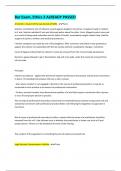
Bar Exam, Ethics 2 ALREADY PASSED
A Solicitor v Council of the Law Society of NSW - Facts Solicitor committed 4 acts of indecent assault against daughters of partner. Complaint made in relation to 2 acts. Solicitor admitted 2 acts and informed police about the other 2 acts. Alleged conduct occurred as a result of being made redundant and his father ill health. Immediately sought medical help. Had the support of partner, children and medical practitioners. I further complaint was made by one of the daughters. After convictio...
- Exam (elaborations)
- • 14 pages •
A Solicitor v Council of the Law Society of NSW - Facts Solicitor committed 4 acts of indecent assault against daughters of partner. Complaint made in relation to 2 acts. Solicitor admitted 2 acts and informed police about the other 2 acts. Alleged conduct occurred as a result of being made redundant and his father ill health. Immediately sought medical help. Had the support of partner, children and medical practitioners. I further complaint was made by one of the daughters. After convictio...
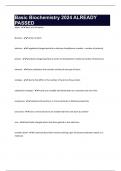
Basic Biochemistry 2024 ALREADY PASSED
Atom - basic unit of matter Nucleus - center of atom electron - negatively charged particle in electron cloud(atomic number = number of protons) proton - positively charged particle at center of atom(atomic number & number of electrons) element - pure substance that consists entirely of one type of atom. isotopes - atoms that differ in the number of neutrons they contain radioactive isotopes - nuclei are unstable and break down at a constant rate over time compound - substance formed by 2...
- Exam (elaborations)
- • 6 pages •
Atom - basic unit of matter Nucleus - center of atom electron - negatively charged particle in electron cloud(atomic number = number of protons) proton - positively charged particle at center of atom(atomic number & number of electrons) element - pure substance that consists entirely of one type of atom. isotopes - atoms that differ in the number of neutrons they contain radioactive isotopes - nuclei are unstable and break down at a constant rate over time compound - substance formed by 2...

Biochem - 1st Year 2024
All amino acids contain a central carbon, a side chain (R group), an amino group and a __________ group. - Carboxyl Amino acids can undergo a proton transfer, thus giving both a (+) and (-) charge. This molecular state is called the ________. - Zwitterion Amino acid that are unable to be synthesised from biochemical pathways within a cell have to be consumed through dietary intake. These are called _______ amino acids. - Essential When two amino acids join together, they are joined by an a...
- Exam (elaborations)
- • 16 pages •
All amino acids contain a central carbon, a side chain (R group), an amino group and a __________ group. - Carboxyl Amino acids can undergo a proton transfer, thus giving both a (+) and (-) charge. This molecular state is called the ________. - Zwitterion Amino acid that are unable to be synthesised from biochemical pathways within a cell have to be consumed through dietary intake. These are called _______ amino acids. - Essential When two amino acids join together, they are joined by an a...
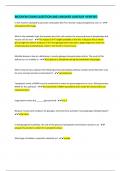
BIOCHEM EXAM QUESTION AND ANSWER ALREADY VERIFIED
In the reaction catalyzed by pyruvate carboxylase (the first reaction in gluconeogenesis), CO 2 is - activated by ATP enegy What is the metabolic logic that explains why liver cells contain the enzyme glucose-6-phosphatase but muscle cells do not? - The reason G-6-P is highly available in the liver is because that is where gluconeogenesis (which produces G-6-P) and glycogenolysis take place. glugoneogenesis needs the enzyme glucose-6-phosphotate, which is not found in muscle tissue. McArd...
- Exam (elaborations)
- • 2 pages •
In the reaction catalyzed by pyruvate carboxylase (the first reaction in gluconeogenesis), CO 2 is - activated by ATP enegy What is the metabolic logic that explains why liver cells contain the enzyme glucose-6-phosphatase but muscle cells do not? - The reason G-6-P is highly available in the liver is because that is where gluconeogenesis (which produces G-6-P) and glycogenolysis take place. glugoneogenesis needs the enzyme glucose-6-phosphotate, which is not found in muscle tissue. McArd...

Biochem Mehlman QUESTION AND ANSWER REVISION TEST
High plasma glucose levels (i.e., in diabetes mellitus) = high intracellular sorbitol levels. What intracellular enzyme that converts glucose to sorbitol? aldose reductase Sorbitol can _________________________________________ cause osmotic injury to cells because it leads to greater intracellular retention of water relative to glucose, thereby causing cellular swelling how to cataracts or neuropathy develop in diabetes due to osmotic injury to cells nephropathy, retinopathy, and athero...
- Exam (elaborations)
- • 55 pages •
High plasma glucose levels (i.e., in diabetes mellitus) = high intracellular sorbitol levels. What intracellular enzyme that converts glucose to sorbitol? aldose reductase Sorbitol can _________________________________________ cause osmotic injury to cells because it leads to greater intracellular retention of water relative to glucose, thereby causing cellular swelling how to cataracts or neuropathy develop in diabetes due to osmotic injury to cells nephropathy, retinopathy, and athero...

Biochem organic question and answer revision test passed 100%
organic molecules - proteins, carbohydrates, lipids, Protein building block - amino acids Carbohydrates - Broken down to glucose to provide energy. Carbohydrates building blocks - simple sugars / gluclose fats/lipids building blocks - Fatty acids Protein food/product - Meats/fish Carbohydrates food/product - Breads, veggie , fruit Fats food/product - oils, butter , wax Substrate - Anything an enzyme works on chemical reaction - Any time something breaks down or put together Synthesis -...
- Exam (elaborations)
- • 2 pages •
organic molecules - proteins, carbohydrates, lipids, Protein building block - amino acids Carbohydrates - Broken down to glucose to provide energy. Carbohydrates building blocks - simple sugars / gluclose fats/lipids building blocks - Fatty acids Protein food/product - Meats/fish Carbohydrates food/product - Breads, veggie , fruit Fats food/product - oils, butter , wax Substrate - Anything an enzyme works on chemical reaction - Any time something breaks down or put together Synthesis -...
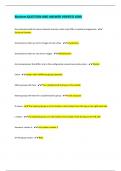
Biochem QUESTION AND ANSWER VERIFIED 100%
Are molecules with the same molecular formula, which only differ in spatial arrangements - Structural isomers stereoisomers that are mirror images of each other - enantiomers stereoisomers that are not mirror images - diastereomers Are stereoisomers that differ only in the configuration around one carbon atom - Epimer Chiral - carbon with 4 different groups attached Aldose groups will have - The c double bond O group on the outside Ketose groups will have the c double bond O group - In t...
- Exam (elaborations)
- • 2 pages •
Are molecules with the same molecular formula, which only differ in spatial arrangements - Structural isomers stereoisomers that are mirror images of each other - enantiomers stereoisomers that are not mirror images - diastereomers Are stereoisomers that differ only in the configuration around one carbon atom - Epimer Chiral - carbon with 4 different groups attached Aldose groups will have - The c double bond O group on the outside Ketose groups will have the c double bond O group - In t...
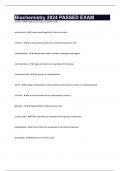
Biochemistry 2024 PASSED EXAM
protein - made up of chains of amino acids amino acids - many joined together to form a protein enzyme - a protein which speeds up a chemical reaction in cells carbohydrates - compounds made of carbon, hydrogen and oxygen carbohydrates - sugar and starch are examples of this group monosacharide - monomer of carbohydrates starch - a large carbohydrate made by plants molecule also known as a polysaccharide cell wall - a structure made of the carbohydrate cellulose glycogen - polysaccharide...
- Exam (elaborations)
- • 2 pages •
protein - made up of chains of amino acids amino acids - many joined together to form a protein enzyme - a protein which speeds up a chemical reaction in cells carbohydrates - compounds made of carbon, hydrogen and oxygen carbohydrates - sugar and starch are examples of this group monosacharide - monomer of carbohydrates starch - a large carbohydrate made by plants molecule also known as a polysaccharide cell wall - a structure made of the carbohydrate cellulose glycogen - polysaccharide...

Biochemistry Enzymes REVISION test already verified 100%
enzymes - important biological catalysts Key features: lower activation energy increase rate of reaction (kinetics) do not alter equilibrium constant are not changed or consumed in the reaction (appear in both reactants and products) --> far fewer enzymes are required relative to overall amount of substrate because one enzyme can act on many molecules of substrate over time are pH- and temperature sensitive, with optimal activity at specific pH ranges and temperatures do not affect o...
- Exam (elaborations)
- • 11 pages •
enzymes - important biological catalysts Key features: lower activation energy increase rate of reaction (kinetics) do not alter equilibrium constant are not changed or consumed in the reaction (appear in both reactants and products) --> far fewer enzymes are required relative to overall amount of substrate because one enzyme can act on many molecules of substrate over time are pH- and temperature sensitive, with optimal activity at specific pH ranges and temperatures do not affect o...
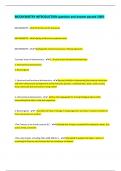
BIOCHEMISTRY INTRODUCTION question and answer passed 100%
BIOCHEMISTRY - •chemistry of life processes BIOCHEMISTRY - •Study of life at the molecular level BIOCHEMISTRY - •Studying the chemical processes of living organisms 3 primary areas of biochemistry: - 1. Structural and functional biochemistry 2. Informational biochemistry 3. Bioenergetics 1. Structural and functional biochemistry - focuses initially on discovering the chemical structures and three-dimensional arrangements of biomolecules (protein, carbohydrates, lipids, nucleic acids...
- Exam (elaborations)
- • 4 pages •
BIOCHEMISTRY - •chemistry of life processes BIOCHEMISTRY - •Study of life at the molecular level BIOCHEMISTRY - •Studying the chemical processes of living organisms 3 primary areas of biochemistry: - 1. Structural and functional biochemistry 2. Informational biochemistry 3. Bioenergetics 1. Structural and functional biochemistry - focuses initially on discovering the chemical structures and three-dimensional arrangements of biomolecules (protein, carbohydrates, lipids, nucleic acids...
